Finding the Balance between Research and Monitoring: When Are Methods Good Enough to Understand Plastic Pollution?
Journal article, Peer reviewed
Published version

Åpne
Permanent lenke
https://hdl.handle.net/11250/3064837Utgivelsesdato
2023Metadata
Vis full innførselSamlinger
- Department of Biological Sciences [2273]
- Registrations from Cristin [10186]
Originalversjon
Environmental Science and Technology. 2023, 57 (15), 6033–6039. 10.1021/acs.est.2c06018Sammendrag
Plastic pollution is an international environmental problem. Desire to act is shared from the public to policymakers, yet motivation and approaches are diverging. Public attention is directed to reducing plastic consumption, cleaning local environments, and engaging in citizen science initiatives. Policymakers and regulators are working on prevention and mitigation measures, while international, regional, and national bodies are defining monitoring recommendations. Research activities are focused on validating approaches to address goals and comparing methods. Policy and regulation are eager to act on plastic pollution, often asking questions researchers cannot answer with available methods. The purpose of monitoring will define which method is implemented. A clear and open dialogue between all actors is essential to facilitate communication on what is feasible with current methods, further research, and development needs. For example, some methods can already be used for international monitoring, yet limitations including target plastic types and sizes, sampling strategy, available infrastructure and analytical capacity, and harmonization of generated data remain. Time and resources to advance scientific understanding must be balanced against the need to answer pressing policy issues.
